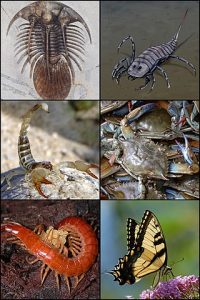Arthropoda
Scientific name: Arthropoda
Higher classification: Ecdysozoa
Phylum: Arthropoda
Kingdom: Animalia
Subkingdom: Eumetazoa

- The number of arthropod species vary between 1,170,000 and 5 to 10 million and account for over 80 percent of all known living animal species.
-
- Arthropods are invertebrate animals with an exoskeleton, a segmented body, and paired jointed appendages.
- They are distinguished by their jointed limbs and cuticle made of chitin, often mineralised with calcium carbonate.
- They are bilaterally symmetrical.
- They possess an open circulatory system.
- Spiders, centipedes, mites, crabs, ticks, lobsters, scorpions, shrimp, are some of the animals found in phylum arthropoda.
- Arthropod species can claim the title of largest by size: the Japanese spider crab (Macrocheira kaempferi).
- The smallest arthropod of any kind (and also the smallest species of crustacean) is Stygotantulus stocki, a tantulocarid. This tiny creature measures only 0.094 mm long, and is an ectoparasite of harpacticoid copepods.
- The first fossil arthropods appear in the Cambrian Period (541.0 million to 485.4 million years ago) and are represented by trilobites, merostomes, and crustaceans.
- Insects are the most diverse of the five classes of arthropods. Insects are the most diverse because they have been on the Earth longer than other arthropods and had time to develop and evolve in their biodiversity.
- Most endangered Arthropod is land lobster (Dryococelus australis).
-
Arthropods are divided into four major groups:
- insects;
- myriapods (including centipedes and millipedes);
- arachnids (including spiders, mites and scorpions);
- crustaceans (including slaters, prawn and crabs).
